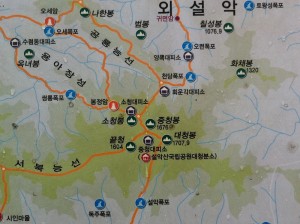With Chinese characters, what we know as ‚reading‘ becomes a desperate attempt to recognize graphical shapes. And even after more than a month in China we hardly know enough to identify city names and book train tickets.
The Korean writing system on the other hand is the work of a genius. It also has one graphic character for every syllable, but they are made up of only 30 basic elements, vowels and consonants, and in combinations can create millions of characters. It is called Hangeul and was developed in the 14th century. Its inventors claimed that „A wise man can acquaint himself with them before the morning is over; a stupid man can learn them in the space of ten days.“
Well, after significantly more than one morning, we can read most Korean now, albeit very slowly (I guess after learning Hebrew we have developed a certain curiosity for different writing systems).  However, reading doesn’t equal understanding. We obviously don’t know many Korean words – just like we didn’t know Russian vocabulary after having acquainted ourselves with the Cyrillic alphabet. Yet it is good enough to read city or station names, to find a few dishes on a menu or just to be in awe of a uniquely clever writing system.
However, reading doesn’t equal understanding. We obviously don’t know many Korean words – just like we didn’t know Russian vocabulary after having acquainted ourselves with the Cyrillic alphabet. Yet it is good enough to read city or station names, to find a few dishes on a menu or just to be in awe of a uniquely clever writing system.
The graphic above from Wikipedia shows the word Hangeul written in Hangeul. Most characters consist of 2-3 elements: an initial (consonant), middle (vowel) and sometimes a final (consonant) and it works like LEGO. A few examples: If you take the first character 한 (han) and replace the first element ㅎ (h) with ㅅ (s) you get ’san‘ which looks like this 산 and means mountain (like in Chinese, where they use this character showing three peaks of a mountain range 山). If you put a ㅂ (b) in the beginning and you will be able to read 반 (ban), meaning half.  Or you can replace the (vertical) middle vowel ㅏ (a) with ㅜ (u), and you can write 분 (bun), meaning minute (instead of on the right of the b the horizontal u moves underneath the b). And importantly, with the element ㅆ (ss) we get 싼 (ssan), cheaper ;-)
Or you can replace the (vertical) middle vowel ㅏ (a) with ㅜ (u), and you can write 분 (bun), meaning minute (instead of on the right of the b the horizontal u moves underneath the b). And importantly, with the element ㅆ (ss) we get 싼 (ssan), cheaper ;-)
It took a while until Hangeul replaced traditional Chinese characters in the Korean society, but from a traveler point of view, it made things a whole lot easier. Don’t get me wrong, even with a fairly simple script (and the fact that its pronunciation isn’t tonal like Chinese), the language itself is still terribly complicated.


